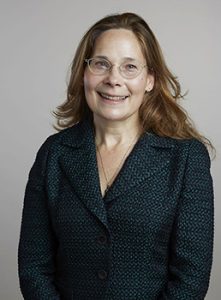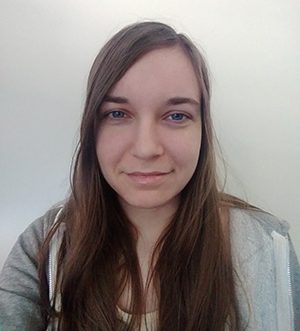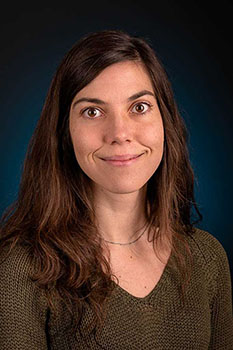Posted on October 22, 2020
 “Making heads or tails of Mediator function, and how transcription start sites earn their STRIPEs”, Gabriel Zentner, Assistant Professor, Department of Biology, Indiana University Bloomington.
“Making heads or tails of Mediator function, and how transcription start sites earn their STRIPEs”, Gabriel Zentner, Assistant Professor, Department of Biology, Indiana University Bloomington.
Precise transcriptional regulation is critical for diverse aspects of biology ranging from cellular differentiation to metabolic homeostasis, and transcription is frequently deregulated in human disease. We use genome-wide approaches to characterize transcriptional initiation, with a focus on Mediator, a modular complex that acts as a bridge between gene-distal regulatory elements and promoters. Our current results suggest that the overall coherence of Mediator’s modules is less important for global transcription than the integrity of the RNA polymerase II-contacting head module, and that the connection of the transcription factor-interacting tail module to the larger Mediator complex is important for limiting transcriptional activation. We also develop new techniques for global characterization of transcription. Our most recent method is Survey of TRanscription Initiation at Promoter Elements with high-throughput sequencing (STRIPE-seq), a simple, rapid, and cost-effective approach for global profiling of transcription start sites (TSSs). STRIPE-seq overcomes limitations of cost, technical difficulty, and/or input associated with current TSS mapping methods and we thus envision that it will be an attractive means by which any molecular biology lab can profile transcription initiation on a whole-transcriptome scale.
Monday November 23, 2020 at 2:30. Join by Zoom
Hosted by Dr. Sheila Teves
Read More | No Comments
Posted on October 13, 2020
 “The interactive behaviour of white-collar workers in biological systems.” by Dr. Joerg Gsponer, Biochemistry and Molecular Biology, Michael Smith Laboratories, UBC.
“The interactive behaviour of white-collar workers in biological systems.” by Dr. Joerg Gsponer, Biochemistry and Molecular Biology, Michael Smith Laboratories, UBC.
Monday, October 19, 2020 at 2:30 pm. Join by Zoom.
Hosted by Dr. Leonard Foster
Read More | No Comments
Posted on September 25, 2020
The Department of Biochemistry & Molecular Biology
proudly presents the
2020 Astell Award Laureates
for their contributions in
Equity, Diversity & Inclusion
Read More | No Comments
Posted on September 22, 2020
 “Three-Dimensional Transmission and Scanning Electron Microscopy of Molecular and Cellular Structures,” by Brian Caffrey, Candidate Subramaniam Lab.
“Three-Dimensional Transmission and Scanning Electron Microscopy of Molecular and Cellular Structures,” by Brian Caffrey, Candidate Subramaniam Lab.
Abstract: Unravelling the complex spatial arrangement of networks and interfaces between proteins, cells and tissues is fundamental to our understanding of healthy and pathological processes. Therefore, a three-dimensional ultrastructural understanding of this arrangement is key to developing modern diagnostic and therapeutic applications in disease. Here, we discuss our application of transmission and scanning electron microscopy techniques such as the Cryo-Electron Microscopy (Cryo-EM) analysis of disease-related mutant protein dynamics; using Focused Ion Beam-Scanning Electron Microscopy (FIB-SEM) to elucidate the 3D structure of muscular mitochondria and in combination with light microscopy, to study nanoparticle-cell interactions.
Zoom presentations – Monday, October 5th, 2020 from 2:30 – 3:00 pm. Zoom link emailed to department members.
Read More | No Comments
Posted on September 21, 2020
 Natalie Strynadka |
 Katie Gyte |
 Laura Meleady |
2020 Astell Award – Presentation to Katie Gyte and Laura Meleady.
Join us for the presentation of the 2020 Astell Award for trainee activities promoting Equity, Diversity and Inclusion (EDI). The short award presentation will be followed by the BMB research seminar.
“Structure-guided antimicrobial discovery using a hybrid atomic toolbox,”by Dr. Natalie Strynadka, Professor, Biochemistry and Molecular Biology, UBC.
Monday, September 28, 2020 at 2:30 pm. Join by Zoom Meeting invitation emailed to department members.
Read More | No Comments
Posted on September 9, 2020
 “Structural Characterization of the Bacterial Injectisome,” by Dorothy Majewski, PhD Candidate, Strynadka Lab.
“Structural Characterization of the Bacterial Injectisome,” by Dorothy Majewski, PhD Candidate, Strynadka Lab.
Abstract: The injectisome is a syringe-like protein complex essential for the virulence of many Gram-negative pathogenic bacteria. As a potential target for drug and vaccine design, studies to elucidate its structure have been ongoing over the past two decades. Two components of this system are essential to its function: the pore-assembling pilotin, and the cytosolic ATPase. Through X-ray crystallography, nuclear magnetic resonance, and cryo-electron microscopy, we have solved the structures of these proteins and learned key details about their interfaces with other members of the injectisome complex. Biochemical experiments have further improved our understanding of the binding and enzyme kinetics of these proteins. These structures have given us insight into injectisome assembly and function, forming a basis for future drug design.
Monday, September 14, 2020 at 2:30, join by Zoom.
Read More | No Comments
Posted on July 28, 2020
Zoom Presentations – Monday, August 10, 2020 at 2:30 pm
 Andrew Alexander – “Understanding Staphylococcus aureus β-lactam resistance: a structural investigation.”
Andrew Alexander – “Understanding Staphylococcus aureus β-lactam resistance: a structural investigation.”
Methicillin-resistant Staphylococcus aureus (MRSA) infections increase mortality and morbidity worldwide, threatening public health. MRSA is resistant to many classes of antibiotics including the most commonly prescribed β-lactam antibiotic class, making treatment of infections difficult. In MRSA β-lactam resistance is primarily mediated by PBP2a, a β-lactam resistant penicillin-binding protein and to some extent, PC1, a β-lactamase. Additionally, β-lactam resistance in S. aureus has also been recently shown to be facilitated independently of PBP2a by mutations in the gene coding for penicillin-binding protein 4 (PBP4), though the mechanisms of resistance have remained mysterious.
In an effort to understand the mechanism of PBP4-mediated β-lactam resistance, two ligand-free and six acyl-enzyme intermediate X-ray crystallographic structures of mutant and wild-type PBP4 were solved. Localized within the transpeptidase active-site cleft, the two substitutions appear to have different effects depending on the drug and findings here suggest PBP4 mediated β-lactam resistance is mediated by at least two separate mechanisms.
The expression of the genes coding PC1 and PBP2a are controlled by two integral membrane proteins: BlaR1 and MecR1 respectively, which consist of a zinc metalloprotease domain and an extracellular C-terminal β-lactam sensing domain which activates the proteolytic domain when acylated by a β-lactam antibiotic. Here, avibactam, a diazabicyclooctane β-lactamase inhibitor, was found to induce expression of pbp2a (which codes for PBP2a) and blaZ (which codes for PC1) in a clinical strain of MRSA. The X-ray crystallographic structures of the BlaR1 and MecR1 sensor domains showing how avibactam binds will be presented.
 Franco Li – “Structural investigation of enzymes in wall teichoic acid biosynthesis and degradation.”
Franco Li – “Structural investigation of enzymes in wall teichoic acid biosynthesis and degradation.”
The bacterial cell wall plays essential roles in defense, survival, and pathogenesis. The common practice of disrupting the assembly of cell wall peptidoglycan with β-lactam antibiotics is no longer effective against many bacterial infections due to the development of resistance mechanisms. New therapeutic agents are urgently needed and will rely on extensive research efforts on additional targets such as the assembly of the Gram-positive bacterial cell wall polymer known as wall teichoic acid (WTA). This polymer is a virulence factor, and it regulates vital cellular processes including cell division. In this seminar, structures of enzymes required for WTA production and degradation are presented, revealing their mechanisms of action and critical features that can be exploited for the design of inhibitors. Inhibition of WTA biosynthesis has the potential to treat methicillin-resistant Staphylococcus aureus infections, widespread hospital- and community-acquired infections that can no longer be eradicated by traditional antibacterial regimes.
Read More | No Comments
Posted on June 10, 2020
 “Studying the roles of dark microglia in aging and neurodegenerative diseases via cutting-edge electron microscopy,” presentation by Dr. Eve Tremblay, Canada Research Chair (Tier II) in Neurobiology of Aging and Cognition, Associate Professor, Division of Medical Sciences, University of Victoria.
“Studying the roles of dark microglia in aging and neurodegenerative diseases via cutting-edge electron microscopy,” presentation by Dr. Eve Tremblay, Canada Research Chair (Tier II) in Neurobiology of Aging and Cognition, Associate Professor, Division of Medical Sciences, University of Victoria.
Abstract:
Microglia, which are the brain immune cells, were shown over the last decade to play important beneficial roles, notably in the remodeling of the neuronal circuits that is required for learning, memory and the adaptation to the environment across the lifespan. In my presentation, I will discuss our recent characterization of an ultrastructurally distinct microglial subtype that is predominantly associated with pathological states, using a combination of transmission electron microscopy, array tomography and focused-ion beam scanning electron microscopy with immunostaining and 3D reconstruction. The dark microglia are rare in healthy young adults, but become highly prevalent upon chronic stress, viral infection, aging, and Alzheimer’s disease pathology, where they account for two-thirds of the typical microglial population. These cells are encountered in various brain regions, including the hippocampus, which is important for cognition. Surprisingly, we also found the dark microglia to be very abundant during normal brain development, in the first postnatal weeks when synaptic pruning mainly takes place. The findings indicate that dark microglia could represent a subset of cells that become stressed as a result of their hyperactive involvement with the remodeling of neuronal circuits across development, stress-induced plasticity, aging, and neurodegenerative disease.
Zoom Presentation: Monday June 22, 2020 from 2:30-3:30 pm
Read More | No Comments
Posted on June 10, 2020
Zoom Presentations – Monday, June 5, 2020 at 2:30 pm.
 Nathanael Caveney – “Structural insights into the activity and modulation of bacterial peptidoglycan synthases.”
Nathanael Caveney – “Structural insights into the activity and modulation of bacterial peptidoglycan synthases.”
 Sean Workman – “A slippery scaffold: structural insights into bacterial cell wall carrier lipid metabolism.”
Sean Workman – “A slippery scaffold: structural insights into bacterial cell wall carrier lipid metabolism.”
Hosted by Dr. Natalie Strynadka
Read More | No Comments
 “Making heads or tails of Mediator function, and how transcription start sites earn their STRIPEs”, Gabriel Zentner, Assistant Professor, Department of Biology, Indiana University Bloomington.
“Making heads or tails of Mediator function, and how transcription start sites earn their STRIPEs”, Gabriel Zentner, Assistant Professor, Department of Biology, Indiana University Bloomington. “The interactive behaviour of white-collar workers in biological systems.” by Dr. Joerg Gsponer, Biochemistry and Molecular Biology, Michael Smith Laboratories, UBC.
“The interactive behaviour of white-collar workers in biological systems.” by Dr. Joerg Gsponer, Biochemistry and Molecular Biology, Michael Smith Laboratories, UBC.


 “Three-Dimensional Transmission and Scanning Electron Microscopy of Molecular and Cellular Structures,” by Brian Caffrey, Candidate Subramaniam Lab.
“Three-Dimensional Transmission and Scanning Electron Microscopy of Molecular and Cellular Structures,” by Brian Caffrey, Candidate Subramaniam Lab.

 “Structural Characterization of the Bacterial Injectisome,” by Dorothy Majewski, PhD Candidate, Strynadka Lab.
“Structural Characterization of the Bacterial Injectisome,” by Dorothy Majewski, PhD Candidate, Strynadka Lab. Congratulations Jasmine! On June 23rd, 2020 Jasmine Li-Brubacher successfully defended her thesis, “A Study in Understanding and Inhibiting Stop-Go Translation in the Dicistrovirus Cricket Paralysis Virus”. Jasmine have been training in Eric Jan’s Lab.
Congratulations Jasmine! On June 23rd, 2020 Jasmine Li-Brubacher successfully defended her thesis, “A Study in Understanding and Inhibiting Stop-Go Translation in the Dicistrovirus Cricket Paralysis Virus”. Jasmine have been training in Eric Jan’s Lab. Andrew Alexander – “Understanding Staphylococcus aureus β-lactam resistance: a structural investigation.”
Andrew Alexander – “Understanding Staphylococcus aureus β-lactam resistance: a structural investigation.” Franco Li – “Structural investigation of enzymes in wall teichoic acid biosynthesis and degradation.”
Franco Li – “Structural investigation of enzymes in wall teichoic acid biosynthesis and degradation.” “Studying the roles of dark microglia in aging and neurodegenerative diseases via cutting-edge electron microscopy,” presentation by Dr. Eve Tremblay, Canada Research Chair (Tier II) in Neurobiology of Aging and Cognition, Associate Professor, Division of Medical Sciences, University of Victoria.
“Studying the roles of dark microglia in aging and neurodegenerative diseases via cutting-edge electron microscopy,” presentation by Dr. Eve Tremblay, Canada Research Chair (Tier II) in Neurobiology of Aging and Cognition, Associate Professor, Division of Medical Sciences, University of Victoria. Nathanael Caveney – “Structural insights into the activity and modulation of bacterial peptidoglycan synthases.”
Nathanael Caveney – “Structural insights into the activity and modulation of bacterial peptidoglycan synthases.” Sean Workman – “A slippery scaffold: structural insights into bacterial cell wall carrier lipid metabolism.”
Sean Workman – “A slippery scaffold: structural insights into bacterial cell wall carrier lipid metabolism.”